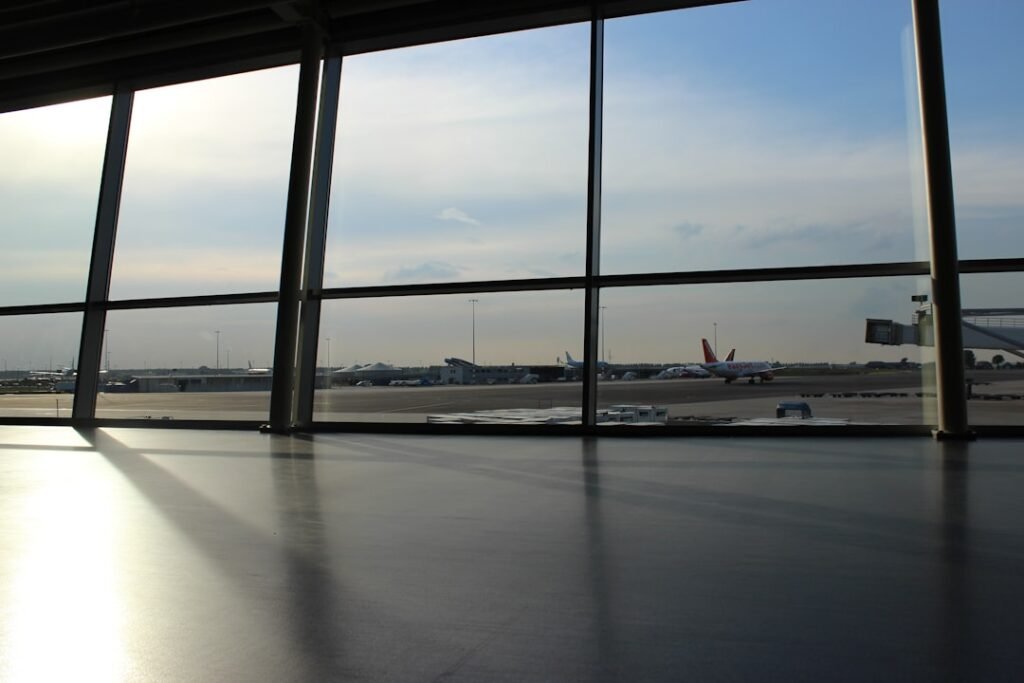Oslo Lufthavn, also known as Oslo Airport or Gardermoen Airport, is the main international airport in Norway. Located in Ullensaker, approximately 35 kilometers northeast of Oslo, it serves as a major hub for both domestic and international travel. With its strategic location and state-of-the-art facilities, Oslo Lufthavn plays a crucial role in connecting Norway to the rest of the world.
History and background of Oslo Lufthavn
Oslo Lufthavn was officially opened on October 8, 1998, replacing the old Fornebu Airport as the main airport serving Oslo. The decision to build a new airport was made due to the limitations and congestion of Fornebu, which could no longer accommodate the growing number of passengers and aircraft.
The construction of Oslo Lufthavn was a massive undertaking, with a budget of over 11 billion Norwegian kroner. The airport was built on the site of a former military airbase, and extensive infrastructure had to be developed to support its operations. The project involved the construction of two parallel runways, a terminal building, cargo facilities, and other necessary infrastructure.
Since its opening, Oslo Lufthavn has undergone several expansion and modernization efforts to meet the increasing demand for air travel. In 2017, a new pier was added to the terminal building, increasing its capacity by 5 million passengers per year. The airport has also invested in advanced technology and systems to enhance efficiency and passenger experience.
Size and facilities of Oslo Lufthavn
Oslo Lufthavn covers an area of approximately 13 square kilometers, making it one of the largest airports in Europe. The airport’s layout is designed for optimal functionality and ease of navigation for passengers.
The terminal building at Oslo Lufthavn is divided into two main sections: the domestic section and the international section. Each section has its own check-in counters, security checkpoints, and departure gates. The terminal is equipped with a wide range of amenities, including shops, restaurants, lounges, and duty-free stores.
In addition to passenger facilities, Oslo Lufthavn also has extensive cargo and maintenance facilities. The airport has dedicated cargo terminals and warehouses to handle the transportation of goods. It also has maintenance hangars and facilities to provide maintenance and repair services for aircraft.
Airlines and routes at Oslo Lufthavn
Oslo Lufthavn is served by a wide range of airlines, both domestic and international. Some of the major airlines operating at the airport include Scandinavian Airlines (SAS), Norwegian Air Shuttle, Wizz Air, and Ryanair. These airlines offer flights to destinations across Europe, as well as to North America, Asia, and Africa.
The airport serves as a major hub for domestic travel within Norway. It offers flights to various cities in Norway, including Bergen, Stavanger, Trondheim, and Tromsø. In addition to domestic routes, Oslo Lufthavn also offers a wide range of international routes, connecting Norway to major cities around the world.
In recent years, there have been some changes in airline activity at Oslo Lufthavn. The rise of low-cost carriers has led to increased competition and the introduction of new routes. Additionally, the COVID-19 pandemic has had a significant impact on air travel worldwide, resulting in reduced flight frequencies and changes in airline schedules.
Transportation and location of Oslo Lufthavn
Oslo Lufthavn is easily accessible by various modes of transportation. The airport is well-connected to Oslo and other cities in Norway through a comprehensive transportation network.
Travelers can reach the airport by train, bus, or car. The airport has its own train station, located directly beneath the terminal building. The Airport Express Train (Flytoget) provides fast and convenient transportation between Oslo Central Station and Oslo Lufthavn, with a travel time of approximately 20 minutes.
There are also several bus services that operate between Oslo Lufthavn and various locations in Oslo and the surrounding areas. These buses provide a more affordable transportation option for travelers.
For those traveling by car, the airport is easily accessible from the E6 motorway. The airport has ample parking facilities, including short-term and long-term parking options.
Despite its convenient location, there are some challenges and opportunities for transportation infrastructure at Oslo Lufthavn. The increasing number of passengers and aircraft pose challenges in terms of traffic congestion and capacity. However, there are ongoing efforts to improve transportation infrastructure and enhance connectivity to the airport.
Security and services at Oslo Lufthavn

Safety and security are top priorities at Oslo Lufthavn. The airport has implemented stringent security measures and protocols to ensure the safety of passengers and staff. These measures include baggage screening, passenger screening, and surveillance systems.
In addition to security measures, Oslo Lufthavn offers a wide range of services and amenities for passengers. The airport has a variety of shops, restaurants, cafes, and bars where travelers can relax and enjoy a meal or a drink. There are also duty-free stores where passengers can shop for tax-free goods.
For passengers who require assistance or have special needs, the airport provides a range of services. These include wheelchair assistance, special seating arrangements, and dedicated assistance points throughout the terminal.
Customer satisfaction is an important aspect of Oslo Lufthavn’s operations. The airport regularly collects feedback from passengers to identify areas for improvement. Overall, the airport has received positive ratings and feedback from travelers, highlighting its efficient operations and excellent customer service.
Passenger traffic and operations at Oslo Lufthavn
Oslo Lufthavn has experienced significant growth in passenger traffic since its opening. In 2019, the airport handled over 28 million passengers, making it one of the busiest airports in the Nordic region. However, the COVID-19 pandemic has had a major impact on passenger traffic, resulting in a significant decline in numbers.
The airport experiences peak travel periods during holidays and summer months when many Norwegians travel abroad for vacation. These periods can be challenging for airport operations, as the increased passenger volume puts pressure on facilities and staff.
To manage operations effectively, Oslo Lufthavn has implemented various measures, including advanced technology and automated systems. These measures help to streamline processes and ensure smooth operations even during peak periods.
The airport is managed by Avinor, a state-owned company responsible for operating Norway’s airports. Avinor works closely with airlines, ground handling companies, and other stakeholders to ensure efficient operations and a positive passenger experience.
Future development plans for Oslo Lufthavn
Oslo Lufthavn has several future development plans to meet the growing demand for air travel and enhance its facilities. One of the major projects is the expansion of the terminal building to increase capacity. The expansion will include the construction of new gates, lounges, and retail spaces.
The airport is also investing in new technologies and innovations to improve efficiency and sustainability. This includes the implementation of digital solutions for passenger services, such as self-check-in kiosks and mobile boarding passes. The airport is also exploring the use of renewable energy sources to reduce its carbon footprint.
Sustainability is a key focus for Oslo Lufthavn’s future development plans. The airport aims to become one of the most environmentally friendly airports in the world by implementing various initiatives to reduce energy consumption and waste generation.
Environmental and sustainable practices at Oslo Lufthavn
Oslo Lufthavn is committed to reducing its environmental impact and promoting sustainable practices. The airport has implemented several initiatives to achieve this goal.
One of the key initiatives is the use of green energy. The airport has invested in renewable energy sources, such as solar panels and wind turbines, to generate clean electricity. This helps to reduce the airport’s reliance on fossil fuels and lower its carbon emissions.
Oslo Lufthavn also focuses on waste reduction and recycling. The airport has implemented a comprehensive waste management system, which includes separate collection of recyclable materials and organic waste. The airport also encourages passengers and staff to participate in recycling programs.
Community engagement and partnerships are important aspects of Oslo Lufthavn’s sustainability efforts. The airport works closely with local communities and organizations to promote environmental awareness and education. It also collaborates with airlines, suppliers, and other stakeholders to develop sustainable practices throughout the aviation industry.
Economic contribution to Norway of Oslo Lufthavn
Oslo Lufthavn plays a significant role in Norway’s economy. The airport is a major employer, providing jobs for thousands of people in various sectors, including aviation, hospitality, and retail. It also generates significant revenue through passenger fees, retail sales, and other commercial activities.
The airport’s strategic location and connectivity have also contributed to the development of tourism and business opportunities in Norway. Oslo Lufthavn serves as a gateway for international tourists visiting Norway’s natural attractions, such as the fjords and mountains. It also facilitates business travel and trade, connecting Norwegian companies to global markets.
In addition to its economic impact, Oslo Lufthavn plays a crucial role in Norway’s transportation and logistics sector. The airport serves as a hub for air cargo operations, facilitating the transportation of goods between Norway and other countries. It also supports the growth of the country’s export industry by providing efficient transportation services.
Travel tips and recommendations for Oslo Lufthavn
For travelers planning to fly from Oslo Lufthavn, there are several tips and recommendations to ensure a smooth and enjoyable experience.
Before the flight, it is important to check the airline’s website for any updates or changes to the flight schedule. It is also advisable to arrive at the airport well in advance to allow time for check-in and security procedures.
When navigating the airport, it is helpful to familiarize yourself with the terminal layout and signage. The airport provides clear signage and information boards to guide passengers to their respective gates and facilities.
Passengers should also be aware of customs procedures and regulations when traveling to and from Oslo Lufthavn. It is important to declare any goods or items that are subject to customs restrictions or duties.
For travelers with some extra time before their flight, there are several local attractions and activities near Oslo Lufthavn. These include museums, parks, and shopping centers. The airport also offers a range of dining options, from fast food outlets to fine dining restaurants.
Oslo Lufthavn is a vital transportation hub for Norway, connecting the country to the rest of the world. With its modern facilities, efficient operations, and commitment to sustainability, the airport plays a crucial role in supporting Norway’s economic development and promoting tourism. As air travel continues to grow, Oslo Lufthavn will continue to evolve and adapt to meet the changing needs of passengers and airlines.
请阅读关于奥斯陆机场的相关文章:挪威语城市和建筑词汇12个著名地点,挪威解饮食食品和饮料8种选择。这些文章将为您提供关于奥斯陆机场以及挪威语中城市、建筑、食品和饮料的相关信息。
FAQs
奥斯陆机场是哪个国家的机场?
奥斯陆机场是挪威的国际机场,位于挪威首都奥斯陆市以北约35公里处。
奥斯陆机场有多少个航站楼?
奥斯陆机场有两个航站楼,分别为主航站楼和北航站楼。
奥斯陆机场有哪些航空公司在此运营?
奥斯陆机场有多家航空公司在此运营,包括挪威航空、斯堪的纳维亚航空、汉莎航空、英国航空、荷兰皇家航空等。
奥斯陆机场有哪些国际航班?
奥斯陆机场有多个国际航班,包括前往欧洲、北美洲、亚洲和非洲等地的航班。
奥斯陆机场有哪些交通工具可以到达市区?
奥斯陆机场有多种交通工具可以到达市区,包括高速列车、公共汽车、出租车和租车等。
奥斯陆机场有哪些餐厅和商店?
奥斯陆机场有多个餐厅和商店,包括餐厅、咖啡厅、快餐店、礼品店、时装店等。

